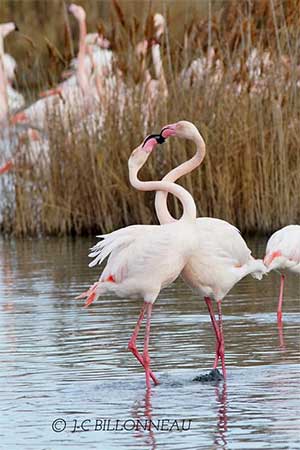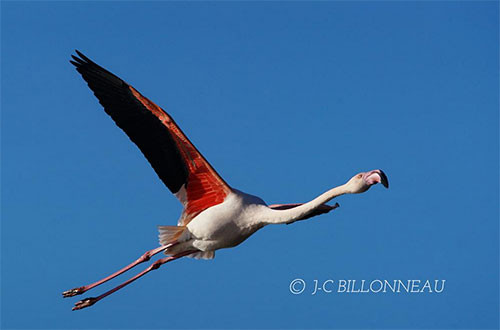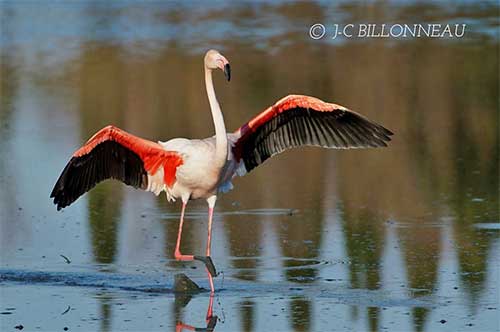
Fr: Flamant rose
All : Flamingo
Esp: Flamenco Común
Ital: Fenicottero
Nd: Flamingo
Sd: Större flamingo
Photographers:
Jean-Claude Billonneau
Photographe-témoin de la Beauté du Monde
Steve Garvie
RAINBIRDER Photo galleries
Text by Nicole Bouglouan
Sources:
HANDBOOK OF THE BIRDS OF THE WORLD vol 1 by Josep del Hoyo-Andrew Elliot-Jordi Sargatal - Lynx Edicions - ISBN: 8487334105
BIRDS OF THE GAMBIA AND SENEGAL by Clive Barlow and Tim Wacher – Helm Field guides – ISBN: 0713675497
BIRDS OF THE MIDDLE EAST by R.F. Porter, S. Christensen, P Schiermacker-Ansen C.Helm - ISBN: 0713670169
L’ENCYCLOPEDIE MONDIALE DES OISEAUX - Dr Christopher M. Perrins - BORDAS - ISBN: 2040185607
THE HANDBOOK OF BIRD IDENTIFICATION FOR EUROPE AND THE WESTERN PALEARCTIC by Mark Beaman, Steve Madge - C.Helm - ISBN: 0713639601
BirdLife International (BirdLife International)
Animal Diversity Web (University of Michigan Museum of Zoology)
Wikipedia, the free encyclopaedia
Greater Flamingo
Phoenicopterus roseus
Phoenicopteriforme Order – Phoenicopteridae Family
INTRODUCTION:
The Greater Flamingo is one of the largest flamingos and occurs in the Old World. This long-legged and long-necked waterbird lives in saline or alkaline lakes, typically in densely packed congregations.
This species is the most widespread and the palest of the six flamingos included in this family.
DESCRIPTION OF THE BIRD:
Biometrics:
Length: 120-145 cm
Wingspan: 140-165 cm
Weight: 2100-4100 g

The adult has soft pink to whitish-pink plumage overall, sometimes very white. However, upper and underwing coverts are coral-red. The flight feathers are black, and contrast strongly against the pale plumage.
The head is similar in colour to the body plumage. Like other flamingos, the Greater Flamingo has well adapted bent bill, with numerous lamellae covering the edges and the inner parts of mandibles. The laterally flattened bill is pink, with black tip and cutting edges.
The eyes are yellow, with narrow, pink eyering. The very long legs and the webbed feet are pink.
Both sexes are similar, but the male is slightly larger with longer legs than the female.
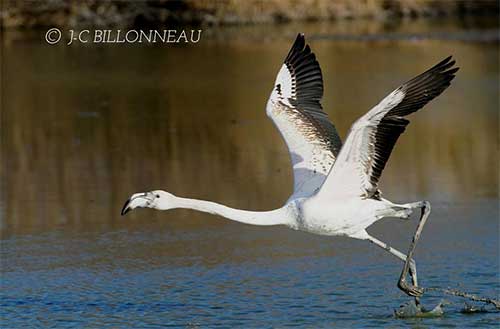
The juvenile is grey-brown with paler underparts. The bill is pale bluish-grey with black tip. The eyes are dark. Legs and feet are grey.
The chick has straight bill and grey down.
RANGE:
The Greater Flamingo is found in southern Spain and southern France, E to Kazakhstan, S through N, W and E Africa to South Africa, and through Middle-East to India and Sri Lanka.
HABITAT:
The Greater Flamingo frequents large, shallow, highly alkaline or saline inland lakes, saline lagoons and estuaries. In W Africa, it is found in sandbanks and mudflats.
This species breeds on mudflats, sandbanks, open beaches and sandy or rocky islands in large waterbodies, sometimes on sandy islands of intertidal areas, especially in Mauritania.
It rarely frequents freshwater areas, except for drinking and bathing.
CALLS AND SONGS: SOUNDS BY XENO-CANTO
The Greater Flamingo’s typical call is a repeated, loud, goose-like honking “ka-ha” in flight. When feeding, it produces a softer, continuous babbling “kuk-kuk, ke-kuk, kuk-kuk…”
We can also hear short nasal grunts. Chicks are very vocal from the start.
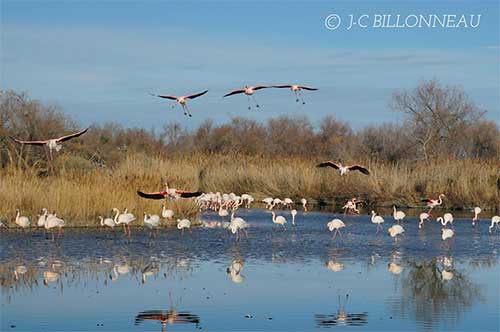
BEHAVIOUR IN THE WILD:
The Greater Flamingo feeds on aquatic invertebrates such as crustaceans, molluscs, annelids and insects (larvae and pupae). It also consumes plant matter such as seeds of marsh grasses, algae, diatoms and decaying leaves. It may occasionally take adult insects, crabs and small fish. It may ingest mud to extract organic matter such as micro-organisms.
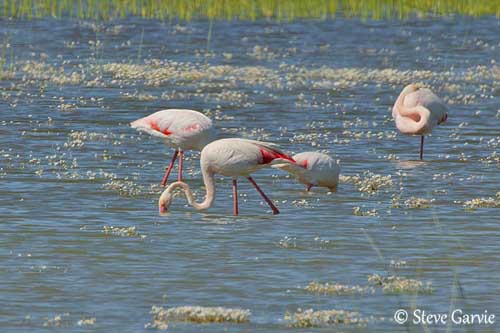
The Greater Flamingo feeds by walking along in water, usually with head and often most of neck submerged in waters of a certain depth.
Thanks to its large size, this species feeds on invertebrates found in the bottom of water. It raises the head at 5-25 seconds intervals for breathing. It sometimes stands and stirs up the mud with its feet to disturb the preys and make them easier to catch.
The bill is held horizontally and pointing backwards. It sucks water and mud, and then, the tongue moves back and forwards like a piston, and the lamellae filter and retain the food.

Several months before, and during the breeding season, the Greater Flamingo spends much time performing collective displays in large flocks tightly packed and highly synchronized.
They perform series of ritualized postures, movements and dances. The most common, the “head-flagging” with stretched neck and head up with bill pointing upwards is spectacular, especially when all birds turn the head from side to side. Wing-spreading and other postures enhance the bright-coloured wing-coverts and the black flight feathers.
The “marching-display” shows the flock walking in one direction before turning tail abruptly.
Before the copulation, the pair leaves the group and some displays are performed, prior to copulation which takes place usually outside the breeding grounds.
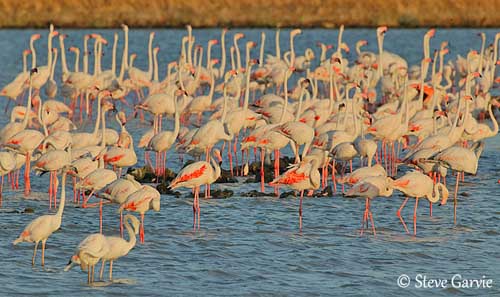
The Greater Flamingo often bathes in shallow fresh water and preens to remove the salt from its feathers. When resting, it usually stands on one leg, with the neck along the back and the head on its rump, but this position is variable.
The Greater Flamingo is partially migratory and dispersive. The populations of the northern parts of the range are fairly regular migrants. They migrate by night and these birds may travel about 500-600 kilometres per night.
In more temperate climate, post breeding dispersions occur, sometimes closely related to weather conditions.
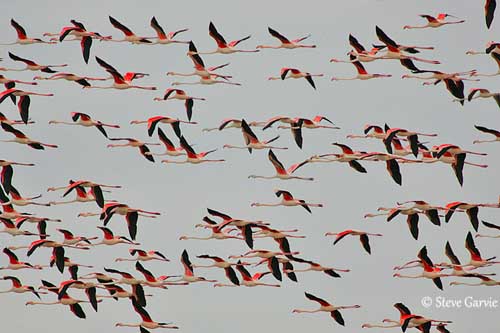
The Greater Flamingo is a good flier, but it needs to run while beating its wings in order to take-off. The flight is graceful and agile, with wingbeats interspersed with short glides. Before the landing, the bird performs a longer glide and runs a few paces when touching the ground.
REPRODUCTION OF THIS SPECIES:
The breeding season occurs generally in spring, with the laying in April in S Europe, in February-March in Tunisia and in May in Kazakhstan.
The Greater Flamingo breeds in dense colonies of up to 20,000 pairs or more.
The nest is a mound of mud, a truncated cone with shallow depression on top. When it nests on rocky islands, the cone is made with stones and debris.
The female lays a single chalky-white egg, rarely two. Both adults share the incubation during 27-31 days. After several days during which the chick is brooded by both parents, it joins a crèche with numerous other chicks. It is fed by regurgitation of “milk” by its parents. It fledges between 65 and 90 days after hatching. It is sexually mature between 4 and 6 years of age.
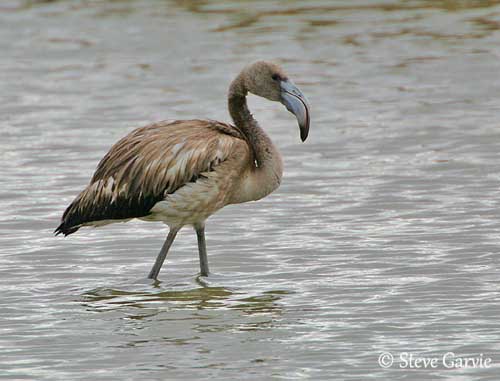
PROTECTION / THREATS / STATUS:
The Greater Flamingo is often disturbed at breeding colonies by human activities and tourists. Low water-levels may affect the breeding success with the decrease of food resources.
In Egypt, this bird is shot or captured to be sold in markets. Egg collecting occurs in some areas too.
But currently, populations appear stable, and the Greater Flamingo is not threatened.
